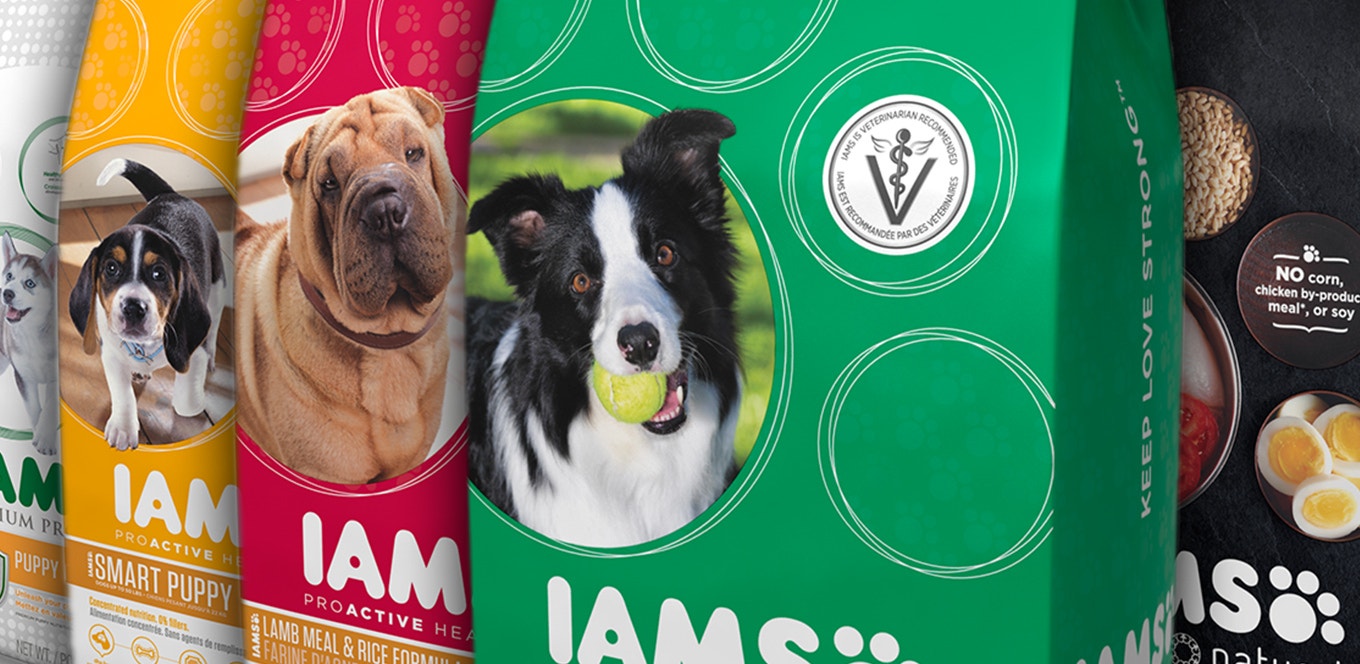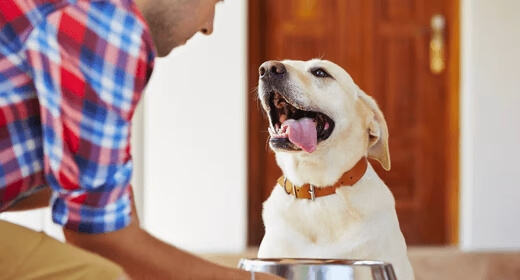

Good nutrition is as important to your dog’s health as it is to your own. But with thousands of different pet foods available, how do you pick the right one for your dog?
Learn how to choose a dog food that provides the proper, balanced nutrition your dog needs to thrive with these six tips.
In general, while a human diet should be high in fiber and low in fat, a dog needs more fat for energy and a healthy skin and coat, and less fiber for good intestinal health.
Preferably, a dog’s food should include meat, too. Even if you prefer a vegetarian diet, designing a high-quality dog diet without animal protein is difficult. IAMS™ Company research supports that meatless meals might not provide optimal nutrition for dogs. Dogs are best fed as carnivores because they have simple stomachs and short intestines that are ideal for digesting animal protein and animal fat. Dogs also need carbohydrates for energy.
Start by identifying your dog’s life stage and lifestyle. Puppies, nursing mothers and mature pets each represent different life stages, and each one has different nutritional requirements. By law, all dog foods must state the life stage for which they are recommended.
Nutritional needs also vary depending on lifestyle. A dog whose primary activity is guarding the couch doesn’t need as much energy as one who guards a flock of sheep. Another factor to consider is breed size: small, medium or large.
Finally, consider medical conditions your dog has, such as food allergies, that might require your veterinarian to recommend a special diet.
Once you’ve determined your dog’s life stage and lifestyle needs, decide whether to feed him dry or canned food. Most dogs do well eating only dry food. Dry foods promote oral hygiene for healthy teeth and gums through abrasive chewing action. Some dogs, especially finicky eaters, enjoy wet food because of its smooth, wet texture.
Remember that while dry food can be left in a bowl all day, wet food should be thrown away after 30 minutes if not consumed. Dry food is the best choice for busy people who are not normally home during the day.
After you determine your pet’s nutritional needs and preference, you are ready to go shopping.
Ingredients on dog-food labels are listed in descending order according to weight. Because dogs thrive on animal-based diets, it’s best to pick a food that features an animal-based protein source, such as chicken, lamb, fish or egg, as the first ingredient. Unlike a single-vegetable-based protein source, such as soybean meal or corn-gluten meal, animal-based protein sources contain adequate amounts of essential amino acids.
Scientific studies show that a combination of carbohydrates in the diet, such as corn meal or barley and grain sorghum, offers optimal carbohydrate digestibility and helps maintain energy levels. In addition, scientific studies show that beet pulp — the material remaining after sugar is extracted from sugar beets — is an excellent fiber source and promotes a healthy digestive tract. Finally, for a glossy coat and healthy skin, your pet needs fat in the diet. Good fat sources include chicken fat and fish oil.
Dog-food labels provide limited information about the nutritional value of the food because labeling regulations do not allow manufacturers to describe the quality of ingredients on the package.
A reputable pet-food manufacturer will be able to explain their specific methods for evaluating and assuring the quality of ingredients used in its products.
When choosing food, the price on the bag, while important, is usually not the best consideration. A low price might indicate inexpensive ingredients, or ingredients that change as market prices fluctuate.
Also, many lower-priced products have higher daily portions to provide the same amount of nutrition found in a high-quality diet. To get a better representation of value, it is the cost per feeding, not the total cost, that counts.
To figure cost per feeding, divide the total cost by the number of days the product lasts. For example, a 20-pound bag of food costs $18.99 and lasts 30 days. The cost to feed is $0.63 per day. A 20-pound bag of food that costs $15.99 and lasts 20 days costs $0.80 per day. So, when costs are analyzed properly, high-quality pet foods compare quite favorably to other brands while offering outstanding nutrition.




As a pet parent, do you find yourself wondering how long does dog food last? If so, you’re not alone! In this blog, we will take you through everything you need to know about dog food expiry.
Dogs require a balanced meal every day. As a pet owner, you can choose between dry and wet foods. Dry dog food usually resembles a biscuit or kibble. On the other hand, wet dog food combines meat products or other protein sources with a gravy that incorporates grains, minerals, and vitamins. Whatever your dog finds palatable, make sure their nutritional requirements are met.
Diets that are high in protein are good for dogs. A significant source of energy is found in dietary fats, which are either derived from plant seed oils or animal fats. They offer essential fatty acids, like omega-3s, that are necessary to preserve the health of your dog's skin and coat. Additionally, carbohydrates support your pet's digestive health and provide energy for them to continue with their regular activities.
While it is important to focus on your pet’s daily nutritional intake, you should also make sure that the food packets are still fresh. Serving expired dog food will deprive your canine companion of the key vitamins and minerals they need to keep healthy. Hence, it is important to examine the labels and expiration dates before making a purchase.
The amount of time a product is useable and suitable for consumption is referred to as its shelf life. In contrast, expiry date is the last day that a perishable product, like food, will be at its highest quality.
If you are wondering does dog food expire, the answer is a yes. In fact, the contents and types of preservatives used do affect the shelf life of a food item. So, to guarantee your dog's safety, pet food producers set expiration or best by dates. Unopened canned foods have a shelf life of two years from the date of manufacturing, whereas unopened dry pet foods typically have a shelf life of 12 to 18 months. Plan to open and use the dog food before the expiration date. You can usually find this date on the bottom of the can containing dog food.
Now that you know dog food expires, let’s examine the effects of serving expired food to your pet:
After consuming spoiled food, dogs generally exhibit the same gastrointestinal symptoms as people do. These symptoms could include vomiting, diarrhea, and passing wind. Spoiled foods can also contain bacteria that can disturb the equilibrium in the gut and intestines, causing the body to excrete more fluids in an effort to wash them out. What’s more is that moldy dog food can contain mycotoxins like vomitoxin, which can cause serious gastrointestinal disorders.
Dogs can become paralyzed from botulism. It is a rare condition occurring when canines consume contaminated food. The poison gets absorbed in the intestines and passes into the bloodstream, thus paralyzing dogs.
Another consequence of feeding your pet spoiled dog food is malnutrition. Before turning moldy, spoiled foods usually lose their vitamin and mineral value. This suggests that even if the food doesn't upset your dog's stomach, it is still not giving your pet what they require. Your dog may become lethargic if daily nutritional demands aren't met. This can eventually result in bone issues and organ failure, if not recognized as early as possible.
Even if you have a food item that is still within its best by date, improper storage could lead to early contamination and food degradation. Here are some steps you must take to prolong the shelf life and maintain food quality:
Purchasing multiple boxes of treats may save you from making repeat visits to the shop. However, keeping so much stock might increase the likelihood that your dog's food goes bad before it gets completely consumed. Therefore, shop frequently if you don’t want your dog’s food to expire.
The shelf life of fresh, wet items can be increased by keeping them in the freezer. Any unopened canned food should be sealed with plastic wrap and stored in the refrigerator.
Use chip clips to seal the food bags and keep moisture out. You could also store your pet’s food in its original packaging and stack it in a cool, dry place with little exposure to heat and light. Avoid keeping dry dog food open.
Dog food that has expired needs to be tossed out right away. There are also waste management facilities that compost used pet food.
If you're looking for the perfect dog for you, try our Dog Breed Selector today and enjoy a lifetime of tail-wagging joy.